
A golf ball, deck of playing cards, tennis ball, baseball, pocket dictionary, and Rubik’s Cube etc. are definitely larger than the mouth of a conventional glass bottle. There’s no way one can pass these objects through a bottle’s narrow mouth. One magician, however, found the way!
Transparent glass bottles containing objects bigger than can be permitted by their mouths and slender necks adorn showcases of the drawing rooms in many houses. There are two different methods followed by artists who specialise in this intriguing art of creating such ‘impossible’ bottles. One method pertains to bottling sailing ship. Naturally, the toy ship with all its sails unfurled on all the three masts cannot be slipped through the narrow mouth of the bottle. Hence it has to be patiently assembled by the artist, component by component inside the bottle. Glued components are lowered one after another in the bottle and ‘shipbuilding’ is carried out with tremendous precision using a pair of tongs till a fine specimen of ‘ship in the bottle’ is ready.
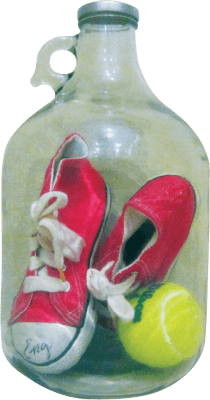 The other method is employed when an apple or some other similar sized fruit has been selected as the object for the impossible bottle. The fruit, along with its branch is inserted into the bottle through the mouth and neck when it is small enough and allowed to grow to its normal size inside the bottle.
The other method is employed when an apple or some other similar sized fruit has been selected as the object for the impossible bottle. The fruit, along with its branch is inserted into the bottle through the mouth and neck when it is small enough and allowed to grow to its normal size inside the bottle.
However, there is not a bit of miracle or magic as far as the ship or the fruit in the bottle is concerned. Both the methods of putting big morsels in small mouths are well-known and practiced by many knick-knack-makers all over the world. Hence, we are going to describe the third method which has been shrouded in mystery for decades. People have failed to make any guesses, let alone reasoned assumptions about how the objects quite larger than the diameter of bottles’ mouth have been put into the bottles. Peruse the photograph on the right which reminds one about the miraculous passage of the camel through the eye of the needle!
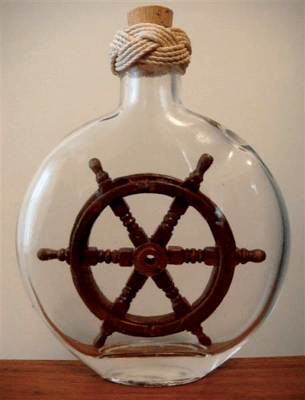 The diameter of the mouth of the bottle is 38 millimetres whereas the tennis ball inside the bottle has the diameter of 65 millimetres. The width of each boot is 75 millimetres or nearly double the width of the mouth of the bottle. It is astounding to learn that the artist of this impossible bottle had inserted the bootlaces through their respective holes and tied the knots after the boots had been placed inside the bottle. But that is not all. He had put his signature reading ‘Eng’ on the toe of the boot as the last finishing touch to his masterpiece after it was complete in every respect.
The diameter of the mouth of the bottle is 38 millimetres whereas the tennis ball inside the bottle has the diameter of 65 millimetres. The width of each boot is 75 millimetres or nearly double the width of the mouth of the bottle. It is astounding to learn that the artist of this impossible bottle had inserted the bootlaces through their respective holes and tied the knots after the boots had been placed inside the bottle. But that is not all. He had put his signature reading ‘Eng’ on the toe of the boot as the last finishing touch to his masterpiece after it was complete in every respect.
The signatory, Harry Eng (Eng pronounced as in engine) was the creator of nearly 600 such bottles—better known as impossible bottles! Inside each of these bottles he had put bigger things than the mouth and neck of the bottle would have permitted. Born in 1931, Eng was an educationist at heart though he plied the profession of a conjuror in California, U.S.A. He used to devise thought-provoking toys and things for school children in order to encourage them to think rather than learn by rote. Making impossible bottles was his favourite hobby. He enjoyed making people, especially students think by putting things like coins, golf balls, packs of playing cards, intact and working electric bulbs, locks, baseball balls and many other things in the bottles. Of course, he never revealed how he inserted such things in the bottles because if he disclosed trick behind his impossible bottles, students might start following the beaten track instead of thinking on original lines.
Photograph of one thought-provoking (and also mind-boggling) impossible bottle is given below. The bottle is wide and flat. Hence, a model of sailing ship’s rudder wheel has fitted inside it so well. Note the narrowness of the mouth and the neck of the bottle. Observe the bottle from any perspective and try to figure out as to how the rudder wheel was inserted in the bottle? Rudder wheel in the bottle is a one-piece, solid wood carving. Hence, there is no question of its having been assembled inside like the ‘ship in a bottle’ or having folded it before lowering in the bottle.
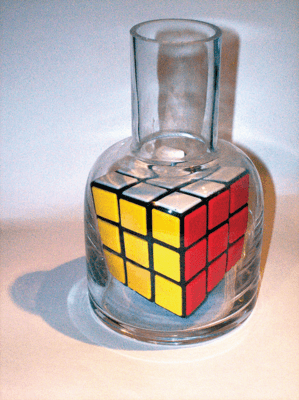 Every one of Harry Eng’s impossible bottles is an enigma which becomes more and more confounding as one tries to fathom its mystery. This feeling becomes all the more striking when one knows the exact dimensions of the object(s) inside the bottle as well as the inner dimensions of the bottle. Peruse photo above of his impossible bottle containing Rubik’s Cube measuring 5.7 X 5.7 X 5.7 centimetres. (Hungarian architect Erno Rubik had invented this mathematical puzzle in 1975). No sane person will say that this Rubik’s Cube could have been pushed through the bottle’s narrow neck.
Every one of Harry Eng’s impossible bottles is an enigma which becomes more and more confounding as one tries to fathom its mystery. This feeling becomes all the more striking when one knows the exact dimensions of the object(s) inside the bottle as well as the inner dimensions of the bottle. Peruse photo above of his impossible bottle containing Rubik’s Cube measuring 5.7 X 5.7 X 5.7 centimetres. (Hungarian architect Erno Rubik had invented this mathematical puzzle in 1975). No sane person will say that this Rubik’s Cube could have been pushed through the bottle’s narrow neck.
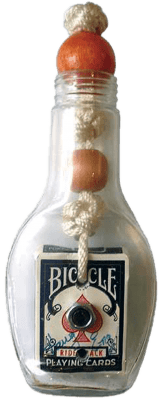 Being a professional conjuror, Harry Eng was very skilful with playing cards. Peruse the photo of one of his masterpieces on the right. This impossible bottle contains three complete packs of playing-cards, back-to-back. A skeptic may argue that Eng might have first lowered duly folded empty packets one by one into the bottle. Thereafter he might have unfolded them into their original shape with a pair of tongs and carefully inserted playing-cards inside them before closing the flaps of the packets. Finally, he must have bored a hole running through the top of all the packs and tied a string through it and embellished the bottle with the decorative marbles.
Being a professional conjuror, Harry Eng was very skilful with playing cards. Peruse the photo of one of his masterpieces on the right. This impossible bottle contains three complete packs of playing-cards, back-to-back. A skeptic may argue that Eng might have first lowered duly folded empty packets one by one into the bottle. Thereafter he might have unfolded them into their original shape with a pair of tongs and carefully inserted playing-cards inside them before closing the flaps of the packets. Finally, he must have bored a hole running through the top of all the packs and tied a string through it and embellished the bottle with the decorative marbles.
Before you concur with the above simplistic explanation, there is the rub: Two steel bolts of different sizes have been passed through all the three packs of playing-cards and fastened with nuts at the ends. Observe the bigger bolt in the middle of the spade symbol and the smaller one beneath it in the panel reading ‘rider pack’. When almost entire inside width of the bottle is thus filled with three packs of cards, how could Harry Eng have run the bolts through them and fastened nuts to them?
Observe the photo of another masterpiece. In this bottle having smaller opening than the bottle described above, three sealed packs of cards are 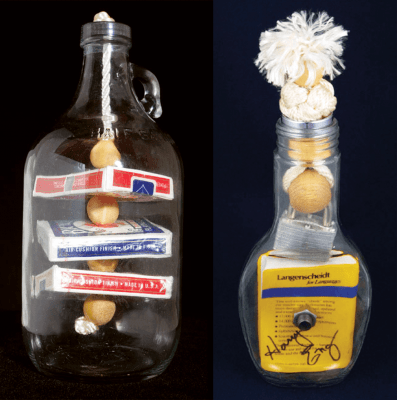 held in horizontal position one above the other. Since it is impossible to roll up an entire pack of playing-cards, the question is how could they have been lowered into bottle? One is left gaping with astonishment as Harry Eng has left no scope for even guesswork as to how he could have contrived this impossible bottle.
held in horizontal position one above the other. Since it is impossible to roll up an entire pack of playing-cards, the question is how could they have been lowered into bottle? One is left gaping with astonishment as Harry Eng has left no scope for even guesswork as to how he could have contrived this impossible bottle.
Every impossible bottle conjured up by Harry Eng is a typical enigma distinct from any of his other creations. One of his impossible bottles is filled up to its neck with tennis balls. The problem is: The diameter of each tennis ball is more than one and a half times greater than the diameter of the bottle’s mouth! Another bottle has a jumble of articles—all larger than the mouth of the bottle—neatly locked together. If Eng had put individual items into the bottle, as he must have invariably done, then how has he tied them together before locking? In another impossible bottle, Harry Eng has not only lowered a pocket dictionary (see, photo) but also run a bolt through it, not to mention the lock and a marble! Yet another impossible bottle having the opening of 3.8 cm diameter contains a 14 cm X 12 cm size sliver of plywood.
When techniques employed by Harry Eng to create his impossible bottles defy all logic, even a normally trustful observer cannot help showing signs of doubt. Couldn’t Harry Eng have got his bottles made around the objects instead of inserting objects through their impossibly narrow mouths? This is precisely the question which some of his friends could not resist asking Harry Eng. In order to satisfy their doubts Harry Eng filled up bottles provided by them with knick-knacks bigger then the mouths and necks of those bottles would have permitted. Most of such bottles were of common products like fruit squashes and liqueurs. bearing the names of their manufacturers embossed on them. Such bottles are the incontrovertible proof of the fact that Eng actually filled objects from their mouths.
Unfortunately this self-effacing genius of impossible bottles passed away in 1996 without revealing the secret of his amazing creations, thereby taking his mysterious techniques to the grave with his mortal remains. Nearly 600 impossible bottles created by Harry Eng exist today. None of the proud owners of Eng’s impossible bottles are ready to part with them despite lucrative offers ranging from 500 dollars to 2,000 dollars per piece.
In the meanwhile another American named Jeff Scanlan appears to have cracked the secret technique of some of the creations of Harry Eng since he has started making and selling such impossible bottles. However, secret techniques behind most of the impossible bottles of Harry Eng continue to remain secret. Perhaps, it is better that Eng’s techniques remain shrouded in mystery; otherwise peerless rarities will become commonplace.
